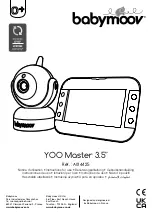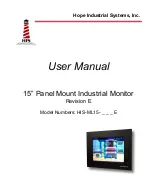
TECHNICAL NOTES
IMPORTANT! To ensure safe and reliable operation, DMR20-1-FM ac
frequency monitors must be installed and serviced by qualified
technical personnel. Contact Murata Power Solutions if there is
any doubt regarding their installation or operation.
1. Measurement Type:
DMR20-1-FM meters are designed to be powered
from sine wave ac supplies, over their rated input of 85-264Vac (45-
65Hz). Operation from triangle, square, and quasi-sine waveforms is
limited to a maximum of 85 to 120rms (45-65Hz).
2. Calibration:
DMR20-1-FM frequency monitors are factory calibrated;
there are no provisions for calibrating these meters in the field.
3. Operating Range:
As the sine wave ac input voltage is lowered below
100Vac (50 or 60Hz), the DMR20-1-FM’s display may begin to dim
slightly, but the readings will remain accurate down to 85Vac. Input
frequencies below 45Hz and above 65Hz will display as four dashes,
indicating an out-of-range input condition.
4. Panel Installation:
All electrical connections to DMR20-1-FM must
be made after the meter is securely attached to the panel, and with
the input ac supply de-energized (off). In high-vibration environments,
adequate strain reliefs must be used on all supply wiring. See Figure 1
for typical panel mounting details.
Tightening
Torque:
The recommended tightening torque for the M30 x 1.5 plastic hex nut
is 10 to 17 in-lbs (1.3 to 1.9 N-m). If a torque wrench is not available,
this recommended range can be approximated by hand tightening the
hex nut SLOWLY until it just bottoms out against the panel’s rear sur-
face. From this bottomed-out reference position, using a suitable tool,
tightening the hex nut ¼ turn clockwise will produce approximately 10
in-lbs (1.3 N-m) of torque; tightening it 3/8 turn clockwise will produce
approximately 17 in-lbs (1.9 N-m).
Check to make sure the housing’s anti-rotation key is aligned with the
notches on both the panel and the gasket before tightening the hex
nut. Over tightening the hex nut will distort the rubber gasket and may
damage the threads on both the nut and the housing, thereby compro-
mising the installation’s mechanical integrity and its ability to protect
against environmental effects.
Panel
Thickness:
When using both the factory supplied EPDM gasket and hex nut (the
recommended standard installation method), the DMR20-1-FM can be
mounted in panels ranging from 0.032” to 0.250” (0.8 to 6.4mm) thick.
When the gasket is not used, the panel thickness range is 0.075” to
0.325” (1.9 to 8.3mm). However, using the factory supplied hardware
and tightening torque recommendations provides optimal resistance to
vibration, dust, and moisture ingress.
!
Panel
Materials:
Acceptable panel materials include aluminum, mild steels, plastics,
FR-4 pc-board (fiberglass), and many other materials with a flat matte
surface on both sides of the cutout. The DMR-20-x-KP tools can be
used with most panel materials except stainless steel or other hard-
ened metals.
DMR20-1-FM has passed vibration testing combined with temperature
cycling while mounted to the materials noted above, using the specified
tightening torques. If the meter will be mounted to extremely smooth,
slippery surfaces, the user is advised to test the completed assembly
under the environmental conditions encountered in the end application.
5. AC Input Fusing and Wiring:
DMR20-1-FM frequency monitors
contain an internal, self-resettable fuse. However, the supply wires
connected to input terminals TB1-A and TB1-B must be fused with an
external, user supplied, 0.25A/300V time delay/time lag fuse, in accor-
dance with applicable regulatory codes.
All supply wiring must be rated for the voltages and currents they will
conduct and comply with any code or application-mandated require-
ments pertaining to the user’s specific installation. 300V, UL-rated
hook-up wire suitable for the intended application is required. TB1 is to
be used only for powering the meter’s internal circuitry; it must not be
used to supply power to external loads.
The recommended TB1 supply wire size is 18AWG to 22AWG (0.83mm
2
to 0.33mm
2
) solid or stranded copper wire. The supply wires must be
properly stripped and attached to TB1 such that their insulation is not
pinched by the screw terminal. Recommended insulation strip length is
0.25” (6.4mm). When using stranded wire, verify that there are no loose
or stray strands that could potentially cause a short circuit across the
ac supply input.
6. AC Input Polarity and Grounding:
The ac supply inputs TB1-A and
TB1-B terminals are not polarity sensitive, that is, neither terminal is
designated as “AC LO” or “AC HI.” DMR20-1-FM frequency monitors do
not include, nor require, a connection to earth/chassis ground.
Figure 1. Panel Installation
www.murata-ps.com/support
DMR20-1-FM
Self-Powered,
LED Display, AC Line Frequency Monitor
MPM_DMR20-1-FM.A02
Page 2 of 3
NANO





















